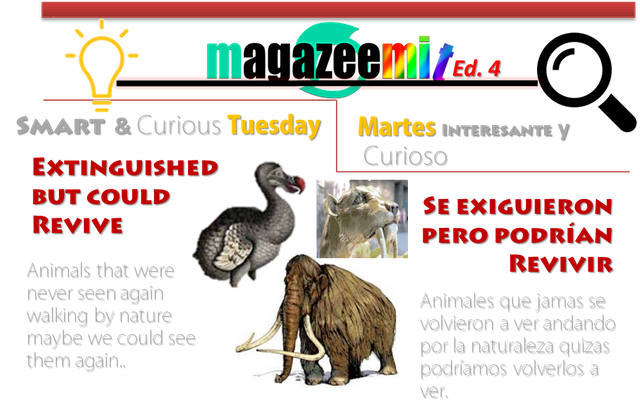Extinguished but could Revive - Se extinguieron pero podrían Revivir / Pg. 2 Magazeemit 4Ed
Magazeemit: Curious and Smart Tuesday

Animals that were never seen again walking by nature maybe we could see them again. Let's learn a little more on this Curious and Smart Tuesday.
Animales que jamas se volvieron a ver andando por la naturaleza quizás podríamos volverlos a ver. Conozcamos hoy un poco mas en este Martes Curioso e Inteligente.

La Cantidad de Material Genético (ADN) y la calidad del mismo son claves para que científicos puedan llevar de nuevo a la vida a todos estos fantásticos animales.
Hallazgos arqueológicos en desiertos y glaseares han revelado cuerpos muy bien conservados incentiva la posibilidad que los científicos logren llevarlos a la vida nuevamente. El cabello y la piel, por ejemplo, poseen alto contenido de material genético. Otra solución es recolectar material genético de parientes directos o lejanos aun vivos. El rompecabezas genético de un total de 10 criaturas ya fue completado con éxito. Aquí algunos ejemplos.
«El bebé de mamut mejor conservado de todos los tiempos se enecuentra de gira por Asia. Lyuba, que es como se llama esta pequeña criatura nacida hace miles de años, permanece ahora en Hong Kong para deleite de científicos y curiosos. Lyuba fue hallada en las montañas de Siberia por un pastor hace cinco años, y se cree murió ahogada hace 40.000 años, cuando la criatura contaba con solo un mes de vida» «Fue un ave no voladora cuya distribución estaba restringida a las Islas Mauricio, en el océano Índico. Desapareció a finales del siglo XVII debido a la caza y el saqueo de sus nidos por parte de los navegantes. Hace seis años, genetistas de Oxford secuenciaron fragmentos de ADN mitocondrial del ejemplar disecado y conservado en un museo. Beth Shapiro, autor de este trabajo, sigue buscando más material genético del dodo, que quizás podría resucitar con ayuda de las palomas.» «Este ciervo gigante vivió hasta hace 7.700 años en Eurasia. Desde el final de las glaciaciones su número disminuyó y dejaron de verse sus cuernos de cuatro metros. Lograr ADN suficiente para reconstruir su genoma no sería difícil, pero sí resucitarlo porque su pariente cercano, el ciervo, es muy pequeño.» «El Smilodon fatalis fue el felino más grande de todos los tiempos. Desapareció hace 11.000 años, al final del Pleistoceno; se cree que debido al cambio climático, aunque la puntilla se la habrían dado los humanos. Los ejemplares mejor conservados se han encontrado en La Brea, en Los Angeles, en unos agujeros de alquitrán de los que no ha sido fácil extraer el ADN. De momento hay muy poco recuperado, pero algunos expertos confían en obtener su genoma. En ese caso, una leona podría ser la donante del óvulo y su madre sustituta.»
El bebe mamut mejor conservado
Dodo de Oxford

Alce gigante irlandés.

Tigre Dientes de Sable
The amount of genetic material (DNA) and the quality of it are key for scientists to bring back to life all these fantastic animals.
Archaeological finds in deserts and glaciers have revealed very well-developed bodies, encouraging the possibility that scientists can bring them to life again. Hair and skin, for example, have a high content of genetic material. Another solution is to collect genetic material from direct or distant relatives still alive. The genetic puzzle of a total of 10 creatures has already been successfully completed. Here some examples.
The best preserved mammoth baby
The best-preserved mammoth baby of all time is on tour in Asia. Lyuba, which is the name of this little creature born thousands of years ago, now stays in Hong Kong to the delight of scientists and onlookers.
Lyuba was found in the mountains of Siberia by a shepherd five years ago, and it is believed she drowned 40,000 years ago, when the baby was only a month old.

Oxford Dodo
It was a non-flying bird whose distribution was restricted to the Mauritius Islands, in the Indian Ocean. Disappeared in the late seventeenth century due to hunting and looting of their nests by navigators. Six years ago, Oxford geneticists sequenced fragments of mitochondrial DNA from the dissected specimen and preserved it in a museum. Beth Shapiro, author of this work, is still looking for more genetic material from the dodo, which could perhaps be resurrected with the help of pigeons.
Irish giant elk.
This giant deer lived up to 7,700 years ago in Eurasia. Since the end of the glaciations their number decreased and they stopped seeing their horns of four meters. Getting enough DNA to rebuild its genome would not be difficult, but it could be resuscitated because its close relative, the deer, is very small.

Tiger Saber Teeth.
The Smilodon fatalis was the biggest cat of all time. It disappeared 11,000 years ago, at the end of the Pleistocene; It is believed that due to climate change, although the lace would have been given by humans. The best preserved specimens have been found in La Brea, in Los Angeles, in tar holes from which it has not been easy to extract the DNA. At the moment there is very little recovered, but some experts trust in obtaining their genome. In that case, a lioness could be the donor of the ovule and its surrogate mother.

See all the creatures in these sources - Mira todas las criaturas en estas fuentes
Fuente1,Source2 Fuente3Fuente4Source5
¡Si te gusto, Vota, Coméntanos, Síguenos, Reestemea, Gracias!

< Pg.1 | Pg. 3 >